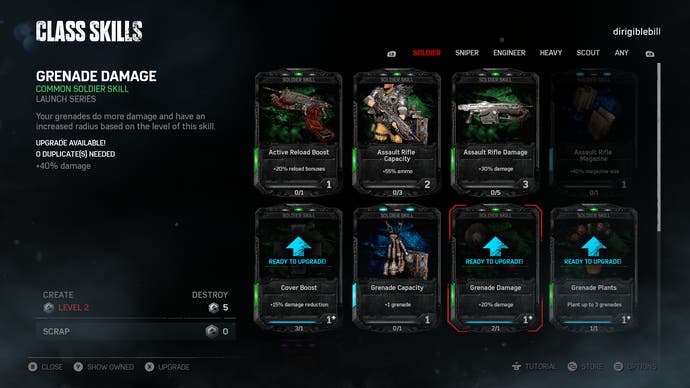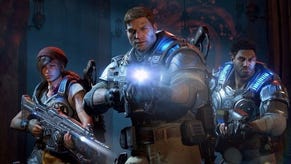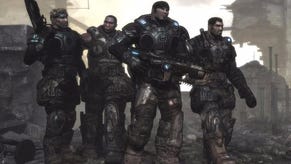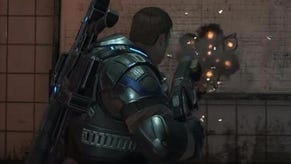Gears of War 4 review
Runs like cogwork.
Editor's note: This is our final review of Gears of War 4, based on time with the full game on live servers. If you want more in-depth impressions on Gears of War 4's campaign, our early impressions piece goes into more detail on the game's single-player.
After 40-odd hours with Gears of War 4, I have just one burning question: how on Earth did this game, the game with characters amassed from leftover dinosaur parts and a rifle you can chop timber with, grow up to be so bloody sensible?
Much of what used to define Epic's series - the sordid wisecracks that positively squelch on impact, those mid-mission swings from apoplectic rage to mushy sentimentality - has been removed or dialled back, as familiar as everything may seem on the surface. It's the return of the prodigal son, now a squeaky-clean graduate with a minor in Renaissance architecture (much of the game's terrain is based upon research trips to north Italy). Sure, he swears like a trooper and isn't above punching the odd skull to pieces, but the days of bellowing about "getting cooties" from mutant offal are well behind us.
One of the notable absences here is Gears 3's Beast mode - a reversal of Horde in which you fight as the hated Locust. I wouldn't call it an essential feature, tragically forgotten, but there's something to be said for the novelty of scuttling across cover layouts as a gigantic mutant centipede. You don't get much of that outright weirdness in Gears 4, though the game's Arms Race mode, a team-based riff on Gun Game in which players obtain a new weapon after every three kills, can be delightfully bonkers. What you get is a sure hand and an eye for detail, a sequel that reins in the crazy while subtly reworking some aged mechanics and variables.
It's not about striking out anew, but polishing up beloved concepts to make them sing for a new generation of players, while overhauling the tech to majestic effect and borrowing a few tricks from younger properties. The campaign adheres firmly to the spookier, sparser, more intimate feel of the original Gears of War, with co-op support for no more than two players, and a story whose principle draw is the deepening magnificence and threat of the environments underfoot. The multiplayer component is dominated by old favourites like Warzone and Guardian, plus some clever reinventions and extensions - a round-based mode that is aimed squarely at the eSports scene, now an important fixture of any shooter's marketing strategy, and a robust versus-AI option to help newcomers learn the ropes.

The game's blend of caution and verve is personified by the new enemy factions, the DeeBees and the Swarm, more properly known as the RoboLocust and the Locust: Necromorph Edition. The former are a visually splendid but slightly monotonous army of bipedal robot soldiers, backed up by rolling seeker bombs and shielded UAVs - you'll encounter them early on and, as Johnny has noted, tire of them quite quickly. The latter are far more entertaining - a race of ghouls, ogres and tentacular abominations who throw the game's duck-and-cover rhythms into mild disarray. Part of the Swarm's appeal, admittedly, lies in working out where exactly they've come from, and if the eventual revelations may dissatisfy, the journey itself is exquisitely imagined and paced.
Both factions have their oddities but are based on well-worn archetypes. The pleasure in fighting them, for a returning fan, is all about seeing what you know bent slightly askew. The same applies to certain new weapons like the Embar, a railgun that forces you to keep your head out of cover while it charges a slug, and the Overkill, a shotgun whose effective range can be extended by holding the trigger. Not all of the tweaks are about advancing the formula, of course - some of them are simply for smoothness, exercises in touching up the paintwork. You can haul an opponent across a cover spot, lining the victim up for a grotty knife execution, or mount a wall at a gallop without slowing down - gentle bits of streamlining that settle in unobtrusively alongside such tactics as the timeless shotgun roll.
Nowhere is the game's wrestle with tradition more obvious than in Horde 3.0, the Coalition's take on Gears 2's famous co-op survival mode, which adds complexity while laying an old series spectre to rest. One of the Xbox 360 trilogy's great dilemmas was how to compete with the unlocks and upgrades treadmill popularised by Call of Duty 4: Modern Warfare - a dilemma that arose from the taut precarity of Gears of War's weapon balancing, which is structured around the out-of-cover duelling potential of the Gnasher shotgun and has proven very resistant to alteration. Gears 4 resolves that issue by leaving the Versus modes upgrades-free save for XP boosters you can activate to accelerate your progress up the ranks, while introducing a robust class and perks system for Horde, where balance is less of a worry.

The foundations of the mode are as in Gears 3 - five players must hold the line against randomised waves of enemies, erecting fortifications such as spike strips and autoturrets to seal off parts of the map. There are 50 waves in total, with enemy toughness and ferocity increasing over time, and every 10th wave is a "boss" encounter featuring one of the bigger nasties from the campaign - Kestrel helicopters equipped with autocannons and rockets, sluggish but overpowering Carriers who spew homing snotballs, and the loathsome, player-swallowing Snatchers.
The key difference is that fortifications (and, if you're short on ammo, weapons) are now assembled at a mobile fabricator, placed at the start of the match, which must be topped up with energy gleaned from the fallen. This creates more of a centre of gravity than in Gears 3, where players were able to roam at whim: placing the fabricator away from the frontline sounds safer, but may cause problems, as you race to return energy to it and deploy fortifications during the 30 second lull between rounds. There's much more emphasis on teamwork, too - the energy pool is shared, so splashing out on a replacement gun may doom your team in the long run, and class skillsets nudge players towards specific roles without being too heavy-handed.
You can, if you're feeling brave or simply idiotic, treat a class as little more than a starting loadout, but making progress past level 20 on even Normal difficulty is all about the chemistry between their traits and abilities. The Sniper may activate a radar ping at the fabricator that marks all enemies on the HUD, for instance - pair this off with a Heavy build that inflicts massive bonus damage when targeting highlighted opponents, and you've got the makings of a serious killing spree. The Scout can equip boosts to health, speed and shotgun stopping power, allowing her to endure long stretches outside the perimeter sponging up juice for the team, while the Soldier is built to dig in, with buffs to resilience when in cover.
Each class has five ability slots, unlocked by levelling the class up through use. Abilities are either obtained with play or bought separately in the shape of the (now-industry standard, it seems) randomised crate system; you can also upgrade them by scrapping duplicate ability cards. It's a framework that rewards investment to a degree previous games never did, though the trade-off is extra fussiness. I'd have appreciated the option to play a vanilla, Gears-2-era Horde mode, for those end-of-day sessions when the fortifications and class strategies feel more like a distraction than an elaboration.

If Horde 3.0 is a little hard to digest, the Coalition's adjustments elsewhere in multiplayer are winningly delicate. One of the star modes is Dodgeball, in which every player you slaughter returns a slain friendly to life, with a respawn queue visible on the HUD. Given comparably skilled teams, this typically leads to some brilliant, last-ditch reversals - one survivor drawing on hidden reserves of audacity or luck to scrape a kill and bring a team back from the brink. It's both a very spectator-friendly mode, and a demonstration of how a change of rules can transform your appreciation of a map - when the odds are 5vs2, working out which nooks are easiest to defend is paramount.
This quiet volatility also characterises Escalation, the game's eSports centrepiece, which is Battlefield's old three-flag Conquest mode played across seven rounds, the twist being that the losing team gets to activate a power weapon spawn between rounds. Placing a tasty toy may only increase your losses, however, as the maps are very symmetrical - a brace of horseshoe layouts, three-lane rectangles and parallel overlooks - and the power weapon spawns are evenly distributed across them. Nothing sharpens the sting of defeat quite like being bombarded by what are rightfully your incendiary grenades as you struggle to secure a plaza. Escalation has a certain narrative baked into it - all the capture points and weapon spawns are reset after round six, clearing the decks to kindle a bit of drama near the finish. It's evidently the result of much study and consultation, and I'm sure it'll attract a committed following, though finding a match right now is a bit of a slog.
Sadly, that's true of much of Gears multiplayer at the time of writing. In the course of a weekend on public servers, I've run into a fair few lost connections, including a Horde match that conked out just after we'd finished off a boss. Maps also take a while to load, often upwards of three minutes, and currently there's a niggling shotgun bug which occasionally doesn't register that a shell has been fired. Launch wobbles are inevitable and none of the blemishes are crippling, but I was hoping for a softer landing given Microsoft's frequent boasts about the quality of its online service.
I was also hoping for a bit more of that old school Epic swagger, that element of unabashed stupidity which gave the world Lancers and a level set inside a Riftworm. On consideration Gears of War 4's issue isn't that it doesn't bring new ideas to the table, but that it's excessively restrained about their usage - the campaign comes to a halt an hour or two after really getting into its stride, and while Arms Race is a hectic diversion, the multiplayer is pegged down a little too firmly by the sober demands of eSports balancing. It's an accomplished revival, and a fine reason to own an Xbox One this Christmas, but expressive of a developer that is holding itself in check. The Coalition has entered the stage on tip toes. Next time I'd like to see it strut.










